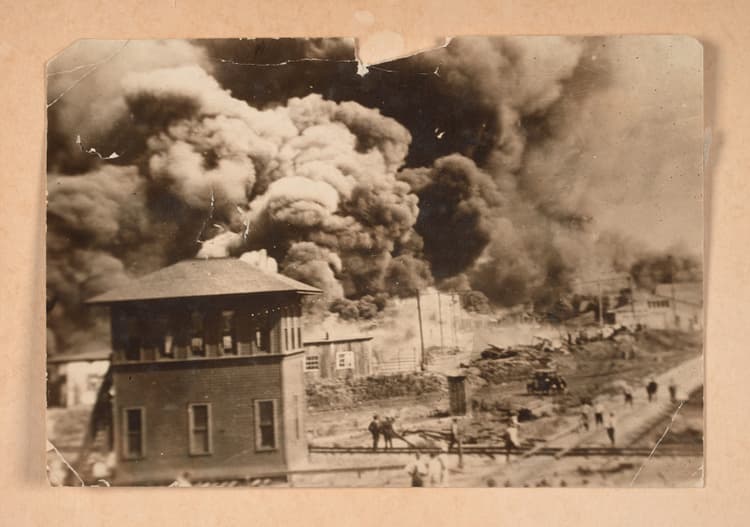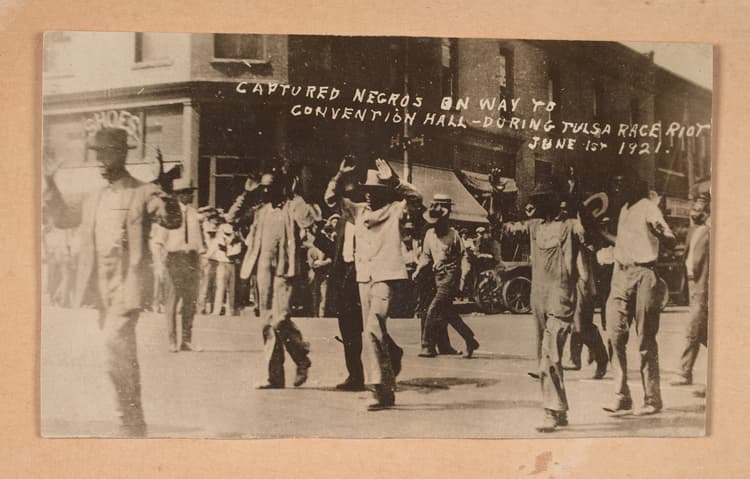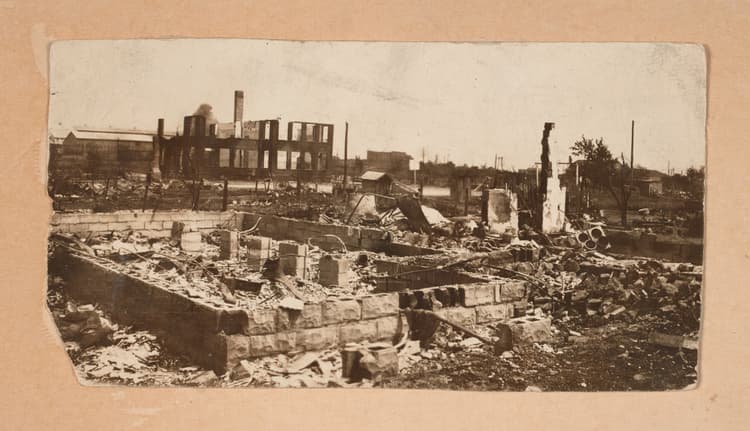White Supremacist Violence and the Red Summer
Adam King
9 min read
Listen to this study note
Study Guide Overview
This study guide covers the Red Summer (1919) and the Great Migration, focusing on the surge in white supremacist violence against African Americans. It examines the causes of this violence, including the return of Black WWI veterans, the Great Migration itself, and post-war instability. Key events like the Chicago Race Riot and the Tulsa Race Massacre are explored. The guide also analyzes African American responses, such as political activism, self-defense, and the Great Migration as a form of resistance. Finally, it examines Claude McKay's poem "If We Must Die" and photographs of the Tulsa Massacre as primary sources, offering practice questions and exam tips.
#AP African American Studies: Red Summer & The Great Migration - Night Before Review 🚀
Hey! Let's get you totally prepped for tomorrow. This guide is designed to be super clear, visual, and engaging, so you can feel confident and ready. We’re going to break down the key stuff, link it all together, and make sure you’re set to ace this exam. Let’s go!
#1. The Explosive Era: 1917-1921
This period was INTENSE. We’re talking about a huge spike in white supremacist violence against African Americans. Think of it as a pressure cooker of racial tension that finally blew its lid. 💥
#1.1. White Supremacist Violence: The Spark
- Key Period: 1917-1921 saw a massive surge in racial violence.
- Red Summer: 1919 was the peak, known as the "Red Summer" due to the bloodshed. 🩸
- Who was Targeted: Black communities across the U.S. were under attack.
- Types of Violence: Lynchings, riots, and racial terrorism were rampant.
Key Concept: This era wasn't just random acts; it was a systematic campaign of terror aimed at maintaining white supremacy.
#1.2. What Fueled the Flames?
- Returning Black Veterans: Black soldiers came home from WWI expecting respect, but faced discrimination and violence. 😠
- The Great Migration: As Black people moved from the South to Northern cities, competition for jobs and housing increased, leading to racial tension.
- Post-War Chaos: Economic and social upheaval after WWI (unemployment, inflation) made things even worse.
Memory Aid: Remember V.M.P (Veterans, Migration, Post-war) to recall the main causes of the violence.
#1.3. Red Summer: The Boiling Point
-
Why "Red"?: The summer of 1919 was marked by so much bloodshed, it was named the "Red Summer."
-
Multiple Factors: The global flu pandemic, job competition, and racial discrimination all played a role.
-
Urban Riots: Over 30 major race riots erupted across the country.
- Chicago Race Riot (July 27 - Aug 3, 1919): Started when a Black teen was killed for crossing a segregation line at a beach.
- Washington D.C. Race Riot (July 19-23, 1919): Triggered by false rumors of a Black man attacking a white woman.
- Elaine Massacre (Sept 30 - Oct 1, 1919): White mobs killed hundreds of Black sharecroppers organizing for better conditions.
Quick Fact: The Red Summer was a turning point, showing just how deeply racism was ingrained in American society.
#1.4. Tulsa Race Massacre: Black Wall Street Destroyed
- Greenwood District: Tulsa, Oklahoma, had a thriving Black community known as "Black Wall Street."
- The Spark: A false accusation against a Black man led to a white mob attacking Greenwood.
- Devastation: Over 1,250 homes and businesses were destroyed, and hundreds of lives were lost.

Caption: The Greenwood district in flames, a stark reminder of the violence of the Tulsa Race Massacre.

Caption: Black men with their hands raised, surrendering during the Tulsa Race Massacre, highlighting the vulnerability and injustice they faced.

Caption: The aftermath of the Tulsa Race Massacre, showcasing the complete destruction of homes and businesses in the Greenwood district.
High Value Topic: The Tulsa Race Massacre is a critical example of the extreme violence and destruction of Black wealth and community during this period. Make sure you understand its causes and consequences.
#1.5. Impact on Black Wealth
- Destruction: Homes and businesses were destroyed in riots and massacres.
- Displacement: Families were forced to flee and start over.
- Loss of Life: Deaths and injuries left families without support.
- Generational Impact: The destruction of wealth prevented Black families from passing down assets, contributing to ongoing economic disparities.
Exam Tip: Remember to connect the violence of this era to its long-term economic consequences for Black communities. This is a common theme in FRQs.
#2. African American Responses: Resistance and Resilience
Despite the brutality, African Americans didn't just sit back. They actively resisted white supremacy and laid the groundwork for future civil rights movements.
#2.1. Resistance to White Supremacy
- Political Activism: Formation of civil rights organizations like the NAACP and UNIA. 💪
- Legal Battles: Lobbying for anti-lynching laws and other legal protections.
- Exposing the Truth: Ida B. Wells-Barnett's journalism documented the horrors of lynching.
- Self-Defense: Some African Americans armed themselves to protect their communities (e.g., Ossian Sweet).
Common Mistake: Don't forget that resistance wasn't just passive; it included active forms of self-defense and community protection.
#2.2. The Great Migration: A New Beginning
- Push Factors (Why Leave the South?): Jim Crow laws, racial violence, limited opportunities, and oppressive sharecropping.
- Pull Factors (Why Go North?): Industrial jobs, less overt racism, and established Black communities.
- Demographic Shift: The Great Migration transformed cities like Chicago, New York, and Detroit.
Memory Aid: Think "PUSH" (Poor conditions, Unjust laws, Segregation, Hardships) for South and "PULL" (Possibilities, Urban jobs, Liberty, Less racism) for North to remember the factors of the Great Migration.
#3. Required Sources: Key Documents & Images
#3.1. "If We Must Die" by Claude McKay, 1919
If we must die, let it not be like hogs Hunted and penned in an inglorious spot, While round us bark the mad and hungry dogs, Making their mock at our accursèd lot. If we must die, O let us nobly die, So that our precious blood may not be shed In vain; then even the monsters we defy Shall be constrained to honor us though dead! O kinsmen! we must meet the common foe! Though far outnumbered let us show us brave, And for their thousand blows deal one death-blow! What though before us lies the open grave? Like men we'll face the murderous, cowardly pack, Pressed to the wall, dying, but fighting back!
- Context: Written during the Red Summer, it's a powerful response to racial violence.
- Themes: Defiance, dignity, and the call for resistance.
- Impact: Became a symbol of Black resilience and a source of inspiration for civil rights activists.
Quick Fact: McKay’s poem is a great example of how art can be a form of resistance and a tool for social change.
#3.2. Photographs from the Tulsa Race Massacre
- Visual Evidence: The photos show the scale of destruction and the human cost of the massacre.
- Historical Significance: They serve as a reminder of the violence and injustice of the era.
#4. Final Exam Focus
Okay, let's focus on what's MOST important for the exam:
- High-Priority Topics:
- The causes and consequences of the Red Summer and the Tulsa Race Massacre.
- The impact of racial violence on Black wealth and economic progress.
- African American responses to white supremacy (political activism, self-defense, Great Migration).
- The significance of Claude McKay’s “If We Must Die.”
- Common Question Types:
- Multiple-choice questions that test your knowledge of key events and figures.
- Short answer questions that ask you to analyze the causes and effects of racial violence.
- Free-response questions that require you to synthesize information from multiple sources and make connections between different units.
#4.1. Last-Minute Tips
- Time Management: Don't spend too long on any one question. Move on and come back if you have time.
- Common Pitfalls: Avoid generalizations and make sure you support your answers with specific evidence.
- Strategies for Challenging Questions: Break down the question into smaller parts, identify the key concepts, and use the sources to support your claims.
Exam Tip: Always refer back to the provided sources in your FRQs. The graders want to see that you can analyze documents and images effectively.
#5. Practice Questions
Let's test your knowledge with some practice questions!
Practice Question
#Multiple Choice Questions
-
Which of the following factors contributed most significantly to the racial violence of the "Red Summer" of 1919? (A) Increased immigration from Europe (B) The return of Black veterans from World War I and increased competition for jobs (C) The passage of new civil rights legislation (D) A decline in the national economy
-
The Tulsa Race Massacre of 1921 is best described as: (A) A labor dispute between white and Black workers (B) A political protest against segregation laws (C) A violent attack by a white mob on a prosperous Black community (D) A conflict between different Black political factions
-
Claude McKay’s poem “If We Must Die” is primarily a call for: (A) Peaceful negotiation with white supremacists (B) Black Americans to leave the United States (C) Armed self-defense and resistance against oppression (D) Black Americans to embrace their African heritage
#Free Response Question
Analyze the causes and consequences of the racial violence that occurred during the "Red Summer" of 1919, and explain how African Americans responded to this violence. In your response, refer to at least one of the provided sources.
Scoring Rubric:
- Thesis (1 point): A clear, historically defensible thesis statement that addresses the prompt.
- Causes of Violence (2 points): Identification and explanation of at least two causes of the racial violence of the Red Summer (e.g., return of Black veterans, Great Migration, post-war economic tensions).
- Consequences of Violence (2 points): Explanation of at least two consequences of the racial violence (e.g., loss of life, destruction of property, economic impact).
- African American Responses (2 points): Explanation of at least two ways African Americans responded to the violence (e.g., political activism, self-defense, Great Migration).
- Use of Source (1 point): Effective use of at least one of the provided sources to support your argument (e.g., analysis of “If We Must Die” or the Tulsa Massacre photos).
- Synthesis (1 point): Demonstrates a complex understanding of the topic by connecting the causes, consequences, and responses to racial violence.
You’ve got this! Take a deep breath, review this guide one last time, and go show them what you know. You’re prepared, you’re smart, and you’re ready to crush this exam! 💪🏾😎
Continue your learning journey

How are we doing?
Give us your feedback and let us know how we can improve





